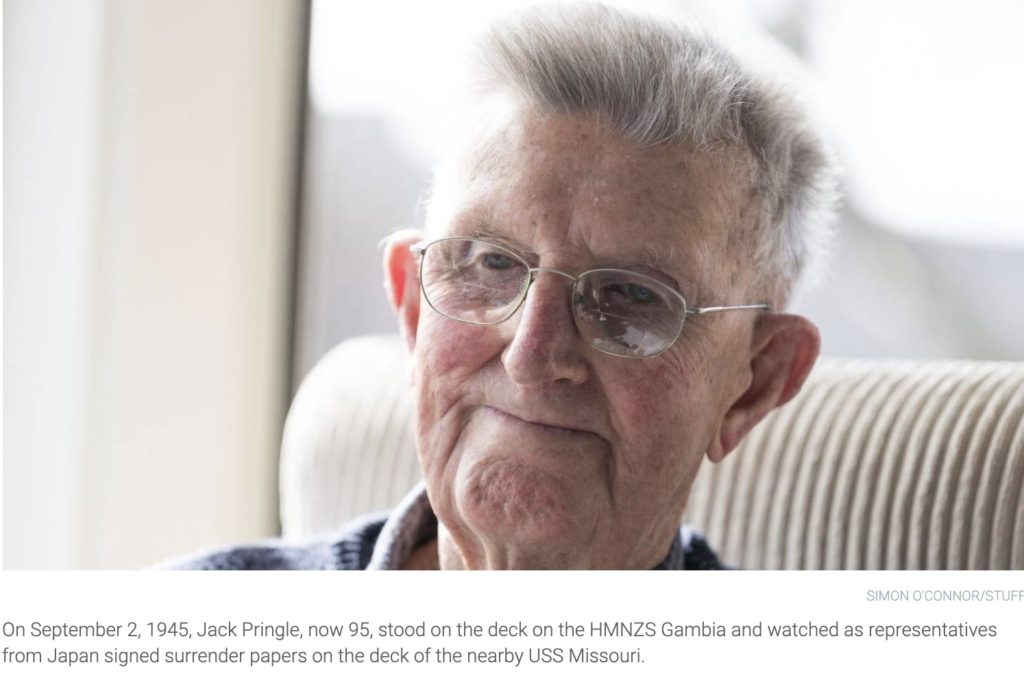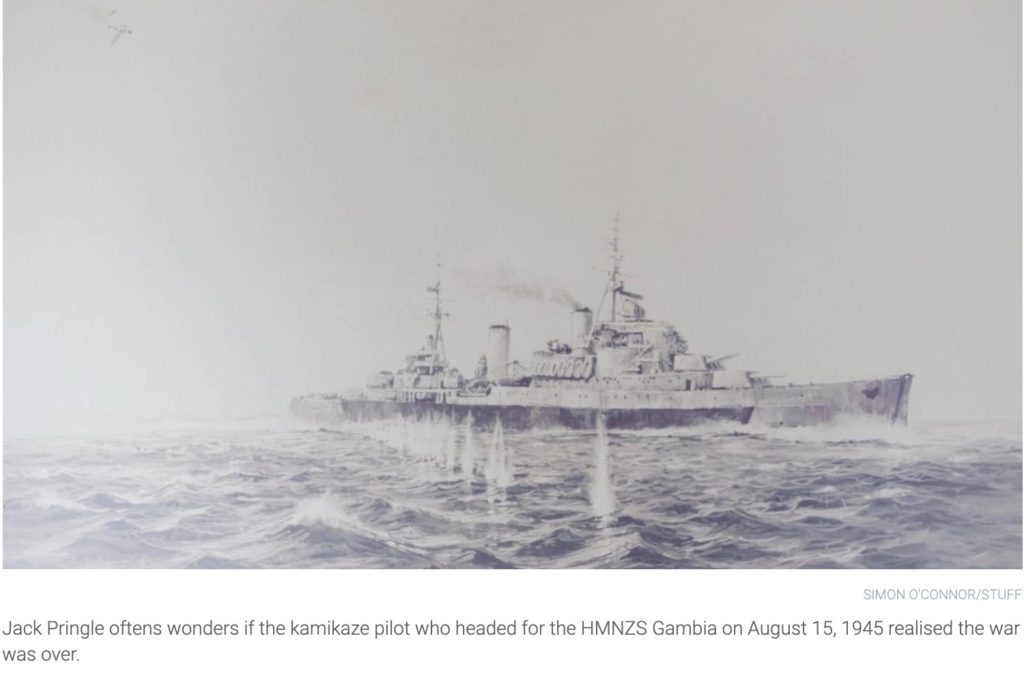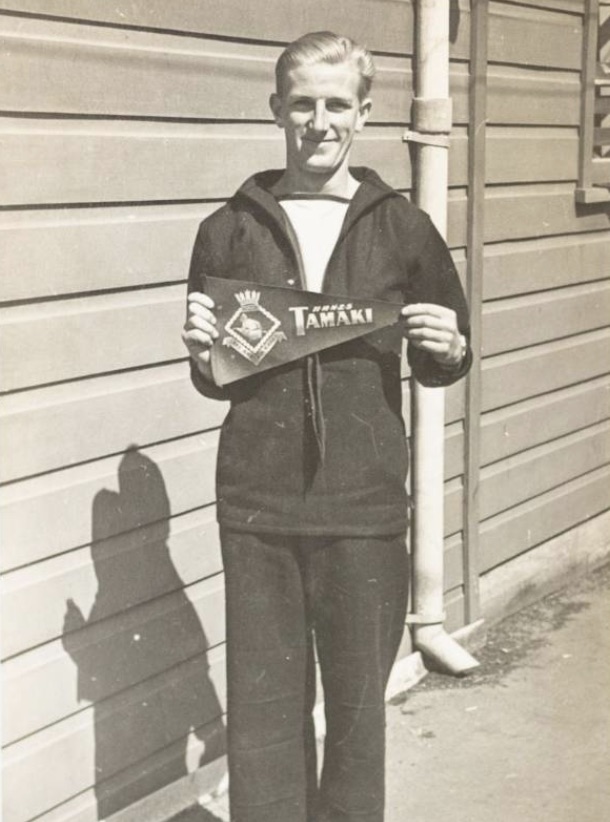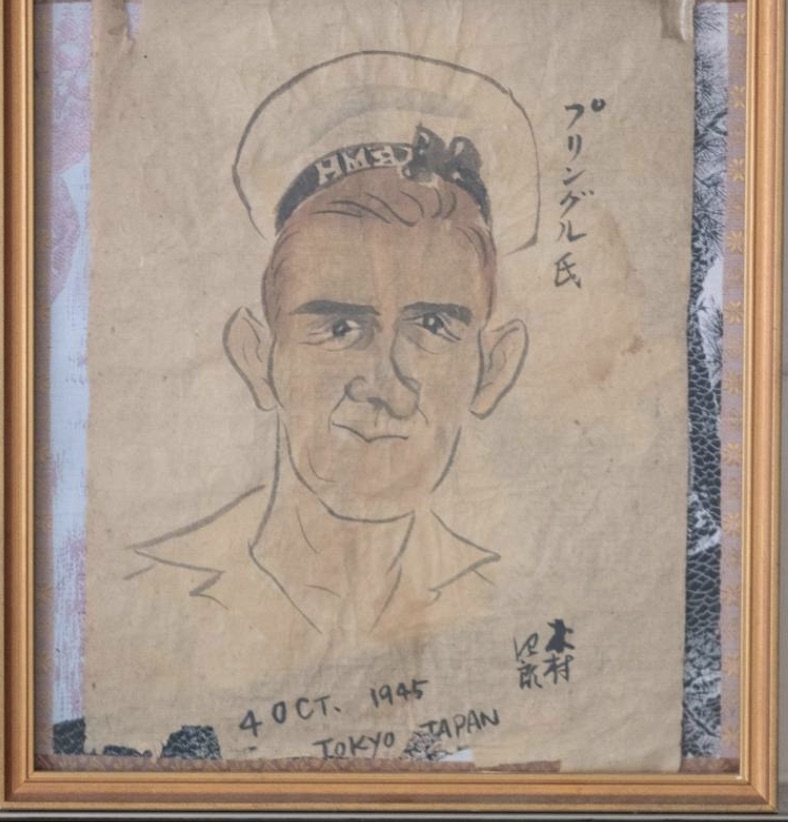‘I wish to hell they’d hurry up’: WWII navy veteran recalls witnessing war-ending Japanese surrender
When Jack Pringle looks back on his time in the Navy during World War II he doesn’t think about watching the authorities officially sign Japan’s surrender on September 2, 1945.

He doesn’t think too much about how, while walking around a flattened Tokyo a couple of days later, he saw, much to his amazement, the Emperor’s palace and surrounding area untouched by American bombs.
Nor does Pringle, 95, think too much about the mostly American and Australian prisoners of war they liberated who looked like ‘’walking skeletons’’.
What he thinks about is the body, still attached to a parachute, he saw floating in the water beside his ship, HMNZS Gambia.
“It could have been a Japanese bomber. I often think about that. What were they like? What sort of family they had. Whether they were married.’’
And he often thinks he’d like to meet up with someone who lived in Tokyo during that time and have a chat.
‘’I’d be very interested to know what part he played in the war. I mightn’t be very pleased with what I heard. He might not be very pleased with me.’’
Pringle points to a framed drawing hanging on the wall of his apartment where he lives independently at the Jean Sandel Retirement Village in New Plymouth.
It’s the Gambia on August 15, 1945. The day Japan surrendered. VJ Day.
‘’That’s the day the kamikaze plane just about had us for dinner,’’ he says.
At 11am the news came through that Japan had surrendered.
‘’We thought this was wonderful. I was up in the radio office, which was up on the bridge.’’
He went up on deck about 20 minutes later and heard gunfire.
The HMS Indefatigable was in front of the Gambia firing its anti-aircraft guns.
‘’This kamikaze came screaming in our general direction, and he was being chased by an American fighter.’’

The picture shows the ‘’cannon fire’’ on the water spraying up like a row of fountains.
Some hit the plane. None hit the Gambia.
‘’By the time the plane was just above our mast height, I think the pilot was dead, the plane was starting to fall apart,’’ he says.
‘’It blew up just behind us, bits and pieces landed all over our ship, but the front part of the plane hit the water about 50 metres in front of us.
‘’I’ve often wondered about the pilot of that plane. He was probably about 18. I wonder if he knew that the war was over, or whether he was determined to give his life.’’
Even now, 75 years later, Pringle can remember that day and the days leading up to it in amazing detail. Of all his service during the war, that week stands out.
Pringle joined the Navy when he was an 18-year-old junior linesman working for the Post Office and Telegraph Department in Ranfurly, Central Otago – ‘’as far from the sea as you can be.’’
He’d never been on a boat, he says.
‘’I joined the navy, because I didn’t want to have to charge anybody with a bayonet on the end of a rifle.’’
He’d already learnt Morse code, so when he went for training he could send and receive Morse quicker than the instructor.

When the Gambia left Auckland in December 1944, telegraphist Pringle was 19.
The Gambia first went to Sydney where she joined the British Pacific Fleet, made up of four British aircraft carriers, two battleships, about four cruisers, and about 25 destroyers, Pringle says.
They later joined up with the American Third Fleet just south of Okinawa, Japan.
That was the last big battle, he says.
‘’We had four aircraft carriers with us and the Americans had about 15. We were sailing right in the middle of the four aircraft carriers and our function was to protect them with anti-aircraft fire, which we did day after day after day.
‘’We were getting attacks from Okinawa, from the Japanese mainland and from the Sakishima Islandswhich were a bit south of Okinawa.’’
He was working day and night – four hours on, four hours off.
‘’You didn’t have much time to wash clothes, eat, it was all pretty frantic.’’
After four hours typing the incoming Morse code he was pretty tired, he says.
‘’It was all in code so you had to be wide awake, you couldn’t guess words. It was a continual stream of signals from the commander in chief of the Americans. After our coders decoded it, it was passed on to the appropriate ships.’’
Then the Gambia detached from the fleet and escorted two air-craft carriers to Taiwan.
‘’The Japanese had taken Taiwan. Our job was to put the airstrip out of action.’’
On their way back to join the fleet they heard the news – an atomic bomb had been dropped on Hiroshima. It was August 6.
‘’We knew there was tremendous devastation and a huge loss of life,’’ he says. ‘’But what we didn’t know what how far the radiation had spread, so we were a bit worried and concerned about that.’’
The Japanese were warned if they didn’t surrender unconditionally they would ‘’get another lot,’’ he says.
So, the Gambia continued to escort aircraft carriers. And the aircraft carriers continued to bomb Japan.
Then, on August 9, the second atomic bomb hit Nagasaki.
At the time the Gambia was bombarding big steel works in Kamaishi on the Japanese mainland, he says.
And the bombing of Japan continued until the surrender on August 15.
The Gambia then joined other Allied ships to go to Tokyo for the official signing of the surrender.
In Sagami Bay, just by entrance to Tokyo Bay, the ship dropped anchor, he says.
‘’I looked out at Mt Fujiyama and said ‘isn’t that wonderful’ and a voice behind me said ‘oh that’s nothing like Mt Egmont’ (Taranaki),’’ Pringle, who has lived in Taranaki for more than 40 years, says, laughing.
The Gambia was met by a Japanese destroyer with the rising sun still flying, he said.
A pilot came across to the Gambia and guided the ship through the mines into Tokyo Bay.
The ship anchored ‘’really close’’ to the USS Missouri, where the official surrender was to take place, he says.
‘’The next day we could see the Japanese, who were going to sign the surrender, all dressed in top hats and frock coats, which I thought was a bit odd.’’
Pringle says he was a very, very small part of what happened.
‘’But it was part of a cog which killed a lot of people. Even those atomic bombs were all out of what we allowed to happen. I’ve often thought, ‘you mightn’t have pulled the trigger, but you were there as part of the team that did’.’’
But when they dropped the bombs the Americans were planning to invade mainland Japan, he says.
‘’We’d have been part of it. And they expected that there would be at least a million people lost.
‘’The other story was Russia had declared war on Japan. They were bringing forces down through Manchuria to take part in the take over of Japan. The last thing the Americans wanted.’’
But on September 2, 1945, as he stood on the deck watching the historic signing, he was wasn’t thinking about any of these things.
‘’Remember I was 20,’’ Pringle says, laughing. ‘’I was thinking, ‘I wish to hell they’d hurry up so that we can go home’.’’

Thanks to Stuff for the article (30 August 2020) and for finding another Communicator

Thank you Jack for a wonderful story and your war efforts.